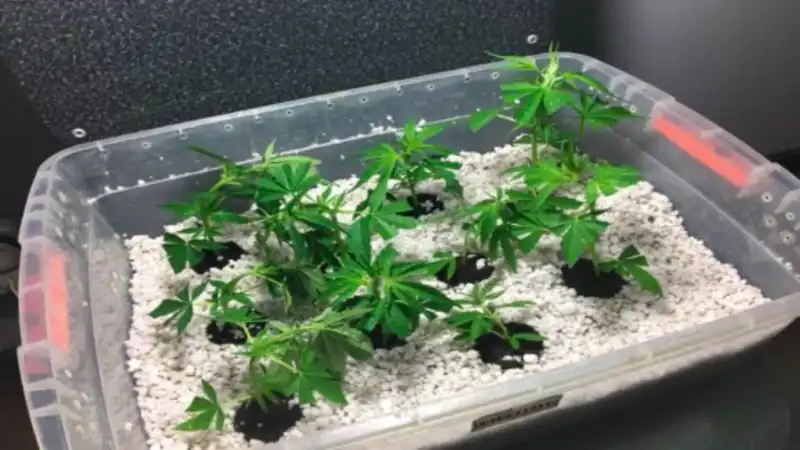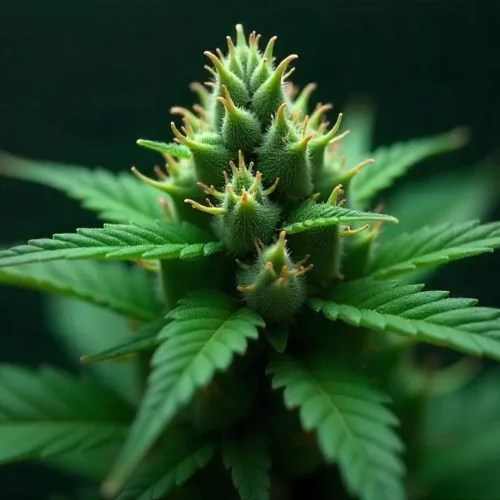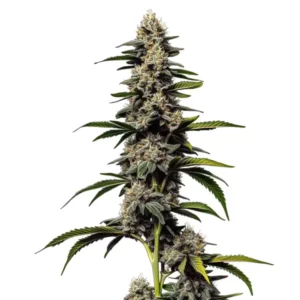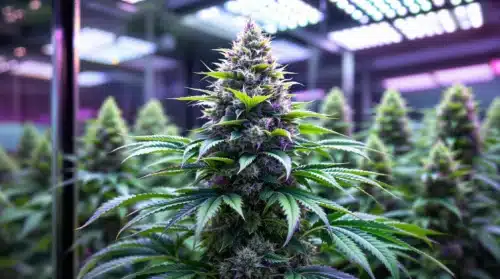Cannabis cloning is a sophisticated horticultural practice that has captivated the interest of cultivators and researchers alike. This process involves creating genetic copies of a parent cannabis plant to reproduce its desirable characteristics without the need for seeds.
By carefully cutting and rooting sections of a healthy, mature plant, growers can produce new plants that are genetically identical to their parent. This technique not only ensures consistency in the crop’s quality, potency, and yield but also allows for the preservation of specific strains with unique traits.
Recommended Strains
Gorilla Glue #4 Autoflower
 THC: 18% - 24%
THC: 18% - 24% Type of seed: Autoflowering
Type of seed: Autoflowering Phenotype: Mostly Sativa
Phenotype: Mostly Sativa Day to flower: 8 - 10 weeks
Day to flower: 8 - 10 weeks
Gorilla Glue #4 Autoflower HMC Edition
 THC: 18% - 24%
THC: 18% - 24% Type of seed: Autoflowering
Type of seed: Autoflowering Phenotype: Mostly Sativa
Phenotype: Mostly Sativa Day to flower: 8 - 10 weeks
Day to flower: 8 - 10 weeks
As the cannabis industry continues to evolve, the art and science of cannabis cloning remain at the forefront of agricultural innovation, offering a fascinating glimpse into the potential of plant genetics and cultivation.
Benefits of Cloning Cannabis
1- For many, the main advantage of clones lies in their ability to replicate the exact genetics of the mother plant. Therefore, if you like the genetics of the mother plant, you will like the genetics of the cloned plant. With clones, there is no genetic variability, which translates to more consistent results in terms of cannabinoids and terpenes. This is beneficial if you are looking for a consistent harvest, and is also the ideal choice when you want to grow something specific, such as a cannabis strain with a particular THC-CBD ratio or a distinctive flavor profile.
2- By using cloned plants, you can enjoy the certainty that they will invariably be female. These represent precise genetic replicas of the mother plant, completely eliminating the likelihood of male individuals emerging.
3- Many marijuana growers favor clones over seeds due to their ability to speed up the growing cycle. While growing from seeds involves the germination phase and care of the seedling before reaching the vegetative state, clones begin their life in a vegetative state. In general terms, this advantage allows the growth time of a plant to be reduced by about three weeks.
Promos & Deals
Setting Up Your Cloning Cannabis Space
Indoor vs Outdoor Cloning Cannabis
The choice between cloning cannabis indoors or outdoors depends on your preferences and resources. Each environment has its own advantages and challenges.
Making clones in open spaces or indoors will depend on the taste and interest of each person. Thus, we can point out that cloning indoors allows you to have full control over environmental conditions, such as light, humidity and temperature. This can result in a more predictable and successful cloning process. However, it can also be more expensive in terms of equipment and electricity. On the other hand, it can also be cloned outdoors where it is usually cheaper and can produce plants that are more resistant to the natural environment. However, you are limited by weather conditions and natural light. You should also consider security and privacy when cloning outdoors.
Choosing the Right Environment
Now, regardless of the growing medium for clones, whether indoors or outdoors, the following points must be taken into account.
1- Light: Clones both indoors and outdoors must have a light source necessary for their optimal development.
2- Temperature: An average temperature suitable for growing clones must be maintained and sudden temperature fluctuations that affect the clones must be avoided.
3- Humidity: The humidity both indoors and outdoors, for clones, should be between 70% to 80% during the rooting phase. This ensures powerful clones and great bud producers.
Selecting the Perfect Mother Plant
To have strong and healthy clones it is necessary to have plants that are in good health, so now we are going to specify the main requirements for mother plants.
Healthy Plants: The mother plant should be free of diseases, pests and stress. It must be robust and vigorous.
Genetics that you want to clone: Obtain those genetics that you want to clone in order to have clones that maintain those varieties that you want to have in your garden.
Age of the plant: A vigorous clone is one obtained from plants that are not too young or very mature.
Traits to Look for in a Healthy Mother
As we already said, cannabis mother plants to obtain clones must be healthy. For that we must fix some details.
Strong stem: A strong stem is essential for the production of quality cuttings.
Healthy nodes and leaves: The nodes are the growth points where the cuttings will develop. The leaves should be green, with no signs of nutrient deficiencies.
Healthy root system: Make sure the mother plant has a root system

Avoiding Common Pitfalls
When cloning cannabis, avoid these common mistakes.
Contamination: Maintain a clean environment and sterilize your tools to prevent diseases and pests.
Overfeeding or undernutrition: Use an appropriate nutrient program for your cuttings and do not overfeed them.
Improper cutting: Learn the proper technique for taking cuttings, including the angle of the cut and removing unnecessary leaves.
Lack of care: Cuttings need constant attention, including adequate watering and humidity, to root successfully.
Lack of patience: Cloning takes time. Don’t expect immediate results and be patient during the process.
Pre-Cloning Cannabis Preparations
Before making the clones, a preparation and analysis of the mother plant from which you want to obtain the clones must be done.
1- The plant must be in the growth phase.
2- The plant must be healthy.
3- The plant must have been trained with LST or similar technique, to have strong arms, which later become clones.
4- Maintain factors such as humidity, lighting, good nutrition, ventilation, among others to have a good mother plant to extract clones.
5- Prune cannabis plants before obtaining clones and also remain patient until the buds are solid and forceful.
Cloning Cannabis Medium Options
The practice of cloning cannabis has become a cornerstone technique for cultivators seeking to maintain consistency, preserve genetics, and ensure the quality of their harvests. At the heart of successful cannabis cloning lies the choice of medium – the substrate in which the new clones will root and begin their growth. This choice is pivotal, influencing not just the survival rate of the clones but also their vigor and the eventual yield. In this comprehensive exploration, we delve into the myriad of cloning medium options available to cannabis growers, highlighting their unique benefits and considerations.
Rockwool: The Sterile Staple Rockwool, made from molten rock spun into cotton candy-like fibers, is a popular choice due to its sterility, aeration, and moisture retention capabilities. It’s particularly favored in hydroponic setups but requires careful pH adjustments before use. Rockwool’s inert nature means it doesn’t introduce any nutrients or biological life to the clones, allowing for a controlled start. However, its environmental impact and the need for protective gear during handling due to potential respiratory irritation are drawbacks worth considering.

Soil: The Natural Foundation Soil is perhaps the most natural medium for cannabis cloning, closely mimicking the plant’s natural environment. It offers a buffer of nutrients and a microecosystem beneficial for young clones. Organic, nutrient-rich soils can enhance the robustness of clones, promoting healthy root development. However, the variability in soil composition and the risk of pathogen presence demand a selection of high-quality, sterilized potting mixes and a careful monitoring of moisture levels to prevent mold and rot.
Coco Coir: The Sustainable Choice Coco coir, derived from coconut husks, stands out for its sustainability, excellent water retention, and aeration properties. It’s a more environmentally friendly alternative to peat moss and offers a neutral pH that can be easily adjusted. Coco coir also promotes strong root growth and is resistant to mold and root diseases, making it a highly favorable medium for cannabis clones. Nonetheless, it requires supplementation with nutrients and careful hydration management.
Aeroponics: The High-Tech Approach Aeroponic systems, which mist the bare roots of clones with nutrient-rich water, represent the high-tech end of cannabis cloning mediums. This method allows for maximum oxygen exposure to the roots, promoting rapid growth and high success rates. While aeroponics systems can yield impressive results, they come with higher initial costs and require precise management of nutrients, pH, and misting cycles. The complexity and potential for mechanical failures make this option best suited for experienced growers with a penchant for technology.
Rock and Clay Pebbles: The Hydroponic Mediums Expanded clay pebbles and other inert hydroponic mediums offer excellent drainage and aeration, supporting the development of healthy root systems in a hydroponic cloning setup. These mediums are reusable and environmentally friendly but require thorough cleaning between uses to prevent disease transmission. They are often used in conjunction with other mediums or systems to enhance oxygenation and support for the clone stems.
Perlite and Vermiculite: The Aerating Additives Perlite and vermiculite, often used in conjunction, provide a lightweight solution that improves aeration and moisture retention in cloning mediums. When mixed with soil or coco coir, they can enhance the physical properties beneficial for root growth and ease of transplantation. However, they primarily act as supplements to other mediums rather than standalone options, requiring careful balance to avoid waterlogging or drying out.
Peat Pellets: The Convenient Capsules Peat pellets, compacted disks that expand upon wetting, offer a convenient and mess-free option for rooting clones. They provide a natural, biodegradable environment conducive to root development but can be prone to drying out quickly and may require frequent monitoring and adjustment of moisture levels. While peat pellets simplify the cloning process, their sustainability has been questioned due to concerns over peatland ecosystems.
Choosing the Right Medium for Your Clones Selecting the optimal cloning medium depends on various factors, including the grower’s experience level, environmental conditions, and specific goals for the cannabis crop. It’s essential to weigh the benefits and limitations of each medium, considering factors such as water retention, aeration, pH stability, and the potential for pathogen presence.
Best Practices for Success Regardless of the chosen medium, several best practices can enhance the success rate of cannabis cloning:
- Ensure clones are taken from healthy, vigorous mother plants.
- Use sterile tools and mediums to prevent disease transmission.
- Monitor and adjust moisture levels to prevent drying out or waterlogging.
- Provide adequate light and warmth to support initial growth.
Soil vs. Hydroponics vs. Aeroponics

Advantages of using soil for clones:
- Earth is a natural and tolerant environment for beginners.
- Provides a stable environment for rooting clones.
- It is cost-effective and readily available.
Cons of using soil:
- The soil can introduce pests or diseases.
- Nutrient availability can be more difficult to control.
- The soil can dry out, causing inconsistent moisture levels.
Advantages of using hydroponics for clones:
- Hydroponic systems can provide precise control over nutrient delivery.
- Faster root development and potentially faster growth.
- Reducing the risk of pests and soil-borne diseases.
Cons of using hydroponics:
- Hydroponic systems can be more complex and expensive to install.
- Regular monitoring and maintenance is required.
- There is less room for error and imbalances can harm clones.
Advantages of using aeroponics in clones:
- Aeroponics can provide an excellent supply of oxygen and nutrients to the roots.
- Faster root development and potentially higher cloning success rates.
- Reduction of the risk of pests and diseases.
Cons of using aeroponics:
- Aeroponic systems can be relatively expensive and require technical knowledge.
- Regular maintenance is essential to avoid system crashes and failures.
- Clones are more sensitive to desiccation in aeroponic systems.
Nutrient Solutions for Cloning
Essential nutrient mixtures used to provide young plants, or cuttings, with the elements necessary for their healthy growth. These solutions are designed to be gentler and more balanced compared to solutions used in later stages of plant growth.
In the initial phase, fertilizer solutions can be used to root, it is also possible to use minimal amounts of vitamins that enhance nutrition and some stimulants to reduce the stress of the clones. Always remember to use all these solutions in minimum quantities to prevent the roots of the clones from becoming blocked, generating a collapse of the crop.

NPK Ratios and Micronutrients
In the context of cloning, NPK ratios are adjusted to meet the specific needs of young plants. Formulas with lower levels of nitrogen (N) to encourage root development and less potassium (K) to prevent excessive growth of the aerial part of the plant are generally preferred. Phosphorus (P) is important for the development of strong roots.
Maintaining Proper pH Levels
In general, the pH of irrigation water for cloning should be in the range of 5.5 to 6.5 for most plants. If the pH deviates significantly from this range, nutrient uptake can be affected, which can lead to nutritional deficiencies or toxicities in young plants, which in turn affects their growth and health.
Sterilization and Sanitization
Sterilization and sanitation are critical when working with cannabis clones to prevent the spread of diseases, fungi, pests and other pathogens that could affect the health and growth of the clones. By maintaining a clean, sterile environment, you reduce the risk of contamination and increase the likelihood that clones will develop healthily.
Keeping Your Workspace Clean
To maintain a clean workspace when working with cannabis clones, you can follow these guidelines:
- Clean and disinfect your work area regularly.
- Use clean and disinfected tools.
- Avoid touching the clones with bare hands.
- Use disposable gloves and change them frequently.
- Wash and disinfect all trays, pots and utensils you use.
- Limit the access of people and animals to the work area.
Preventing Contamination
To prevent contamination of cannabis clones, it is essential:
- Maintain strict control of pests and diseases in the growing environment.
- Isolate and quarantine new clones for a period to check their health.
- Avoid sharing tools or equipment with other growers.
- Carry out careful selection of mother plants to ensure they are free of problems.
- Regularly inspect clones for signs of disease or pests.
The Cloning Cannabis Process
This cannabis cloning process is widely used by growers to ensure the consistency of their crops and preserve the desirable characteristics of the plant. As you know, it allows the reproduction of cannabis plants in an asexual way, allowing homogeneous and high quality harvests.

Taking Cuttings
To take cuttings from a marijuana plant, you must first select a healthy, vigorous mother plant that has the desired characteristics, such as good growth, disease resistance, or high cannabinoid production. Next, cut a branch or cutting from the mother plant.
The cuttings are taken from the lateral branches, although you must be careful that it should not be a satellite lateral branch. Some people prefer to take cuttings in the growth phase 1 week before flowering. On the other hand, others recommend and assure that clones taken in the pre-flowering phase are the best since they believe that they generate more robust, powerful plants that have greater bud production.
Where to Cut for Optimal Results
The ideal place to cut a cutting is just below a node. A node is the area on the stem where leaves and side branches join the main stem. By cutting just below a node, you ensure that the cutting has good potential to develop roots. It is usually cut at a 45° angle to increase the contact surface with the growing medium.
Proper Tools and Techniques
To take marijuana cuttings, it is important to use sterilized tools, such as scissors or sharp blades, to prevent the spread of disease or infection. It is also helpful to use a rooting hormone to aid root development in the cuttings. The cuttings can be placed in a suitable growing medium, such as a rooting substrate or rock wool, as we already told you in this guide, and they should be kept in conditions of high humidity and indirect light to promote rooting. You should also use specialized hormones that you buy at any grow store to promote the creation and propagation of roots.

Rooting Hormones Explained
To successfully root these clones, rooting hormones can be used, which are chemical compounds that stimulate root growth in plants. Below I will provide you with information on the types of rooting hormones and related application methods.
Types of Rooting Hormones
- Indolebutyric Acid (IBA): IBA is a rooting hormone commonly used in plant propagation. It is effective in stimulating root growth in a wide variety of plants, including cannabis.
- Naphthaleneacetic Acid (NAA): NAA is another rooting hormone used in plant propagation. While less common than IBA, it can also be effective in stimulating root growth in cannabis clones.
- Naphthaleneacetic acid (NAA): NAA is a variant of NAA and is sometimes used in place of other rooting hormones. It may have similar effects on rooting cannabis clones.
- Indoleacetic Acid Acid (IAA): IAA is another natural rooting hormone found in plants. Although it is not as common in rooting applications for cannabis clones, it is important in the formation of roots in plants.
Application Methods
Solution Dipping: This method involves dipping the cut end of the clone into a rooting hormone solution before planting it in the growing medium. Be sure to follow the specific dilution instructions for the hormone you are using.
Rooting Powder: You can apply rooting powder directly to the cutting end of the clone after cutting it. The powder adheres to the cut tissue and helps stimulate root growth.
Rooting Gel: Rooting gel is another way to apply hormones directly to the end of the cutting. The gel adheres to the clone and helps in root development.
Spraying: Some people also choose to spray the rooting hormone solution directly onto the clone. This method may be less precise than others and may require more frequent application.
Placing Cuttings in the Medium
To plant a clone in the medium, you must make a hole or space in the medium (jiffy, rockwoll, rooting cube, etc) of your choice and place the cutting in it. Make sure the clone has at least a couple of nodes (where new branches will develop) and is buried enough to keep it stable. Water gently and be sure to maintain a humid environment to encourage rooting.
Creating the Perfect Environment
For rooting clones, it is recommended to provide soft, diffused light, such as fluorescent light or LED grow lights. Avoid bright light, as clones are delicate and can burn easily. Creating a perfect environment for cloning cannabis is essential if you want to propagate cannabis in this way.
For rooted clones, the optimal temperature is usually between 20-25°C. The relative humidity should be high, around 70-80% to promote root development. You can use a propagator or dome to maintain humidity.

Caring for Clones in the Early Stages
During the early stages of growth, clones require special care. You should maintain a warm, humid environment, provide soft, diffused light, and ensure they have access to enough oxygen. Water sparingly to keep the medium moist, but not soggy.
Clones can be transplanted into larger pots once they have developed healthy roots and have good vegetative growth, usually after a few weeks. Make sure the roots fill the current medium before transplanting.
Optimal Cloning Cannabis Conditions
The optimal conditions for cloning cannabis plants are essential to guarantee the success of the process. Here you have information about the ideal conditions for cloning cannabis
Light and Temperature
Light: For the cloning process, it is recommended to provide constant but soft light. Most growers use compact fluorescent or blue spectrum propagation lights to maintain a constant light environment for 18-24 hours a day. This will promote rooting of the clones.
Temperature: Temperature plays a crucial role in the cloning process. A constant temperature of around 24-27°C (75-80°F) is usually maintained in the cloning area. This promotes the activity of the enzymes responsible for rooting.
Humidity and Ventilation
Humidity: During the rooting phase, it is important to maintain high relative humidity (around 90%). This can be achieved by using a dome or lid over the clones to create a humid microclimate.
Ventilation: Although it is important to keep humidity high, it is also essential to provide adequate ventilation to prevent the buildup of mold and mildew. Small openings can be made in the domes to allow air circulation.
Watering and Feeding
Watering: Clones need an adequate amount of water, but it is important to avoid overwatering as this can lead to root rot. They are usually watered with a sprayer or atomizer, making sure that the growing medium is slightly moist. Feeding: Clones do not need strong nutrients at this stage. Typically, mild and balanced nutrient solutions are used. It is also common to apply a rooting agent that stimulates root development.
Troubleshooting Common Issues
Here we show you some common solutions when cloning cannabis. Common nutritional deficiency, yellow leaves, fungal attack such as mold, insects and pests are diseases that affect cannabis plants, even more so clones. Now we see how to face each of the evils that can harm your clone cultivation.

Yellowing Leaves
It can be due to a variety of factors, such as nutrient deficiency (especially nitrogen), unbalanced pH, root problems, or excess light. Make sure the pH of the water and substrate is appropriate, provide balanced nutrients, and make sure the roots are healthy. Adjust the growth environment if necessary.
Wilting or Drooping Clones
This may be due to a lack of water, problems with the root system or high temperatures. Water properly, make sure roots are healthy, and adjust temperature and humidity.
Mold and Fungus
Excessive humidity, lack of ventilation and poor hygiene can contribute to the growth of mold and mildew. Maintain a proper humidity level, improve air circulation, and make sure your grow space is clean and disinfected.
Pests and Diseases
Pests such as mites, aphids and whiteflies, as well as fungal and viral diseases, can affect clones. Regularly inspect plants and use organic or chemical pest control measures as necessary. Isolate infected plants to prevent spread.
Nutrient Deficiencies vs. Overfeeding
A nutrient deficiency can be caused by a lack of essential nutrients, while overfeeding can be caused by too much fertilizer. Use a balanced feeding program and control nutrient uptake by adjusting substrate pH and avoiding excess fertilizers.
Underwatering vs. Overwatering
Underwatering can be due to lack of water, while overwatering can suffocate the roots and cause oxygen problems in the substrate. Make sure the plants receive the appropriate amount of water according to their needs and verify that the substrate has good drainage.
Prevention and Treatment
To prevent problems, maintain a clean and disinfected growing environment, monitor humidity and temperature, and perform regular inspections. To treat problems, identify the root cause of the problem and take specific measures, such as adjusting irrigation, pH, or nutrient supply, or using pest or disease control products.
Identifying and Eliminating Threats
Identifying and eliminating threats involves looking closely at plants for signs of problems, such as yellowing leaves, wilting, spots, or pests. Then, take appropriate measures to address the identified threat, which may include adjusting the growing environment, providing balanced nutrients, or applying specific treatments.
Here are a few strains that are often considered easy to clone:
Blue Dream: This sativa-dominant hybrid is renowned for its vigorous growth and resilience, making it a favorite among both novice and experienced growers. Blue Dream’s hardiness extends to cloning, where it tends to root quickly and easily.
GG4 (formerly known as Gorilla Glue #4): GG4 is a potent hybrid strain that has gained popularity for its strong effects and high resin production. It’s also known for its robust nature, making it relatively easy to clone compared to some other strains.
Green Crack: This sativa-dominant strain is prized for its energetic and uplifting effects. Green Crack’s vigorous growth and resistance to common pests and diseases make it an ideal candidate for cloning, especially for those looking for a quick turnaround.
Northern Lights: As one of the most famous indica strains in the cannabis world, Northern Lights is cherished for its ease of growth, including cloning. This strain is particularly forgiving of mistakes, making it suitable for beginners.
White Widow: Another classic strain, White Widow is a balanced hybrid known for its resilience in various growing conditions. It roots well when cloned, making it a reliable choice for growers looking to replicate a high-quality genetic line.
Skunk #1: As a cornerstone of cannabis breeding, Skunk #1 is known for its robust genetics and ease of growth. This strain has a solid structure and roots quickly, making it a great choice for cloning.
Cheese: Famous for its unique aroma and flavor profile, Cheese is also noted for its straightforward cloning process. It’s a resilient strain that adapts well to different growing environments.
It’s important to remember that successful cloning isn’t just about the strain; it also depends on the grower’s technique, the environmental conditions, and the care given to the clones throughout the rooting process. However, starting with a strain known for its cloning ease can certainly help tilt the odds in your favor.


















